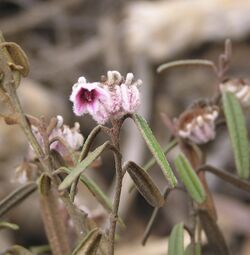Biology:Lasiopetalum parvuliflorum
| Lasiopetalum parvuliflorum | |
|---|---|

| |
| Scientific classification | |
| Kingdom: | Plantae |
| Clade: | Tracheophytes |
| Clade: | Angiosperms |
| Clade: | Eudicots |
| Clade: | Rosids |
| Order: | Malvales |
| Family: | Malvaceae |
| Genus: | Lasiopetalum |
| Species: | L. parvuliflorum
|
| Binomial name | |
| Lasiopetalum parvuliflorum F.Muell.[1]
| |
| Synonyms[1] | |
|
Lasiopetalum parviflorum var. occidentale Benth. | |
Lasiopetalum parvuliflorum is a species of flowering plant in the family Malvaceae and is endemic to the south-west of Western Australia. It is an erect, spreading shrub with hairy stems, oblong to linear leaves and green or cream-coloured flowers.
Description
Lasiopetalum parvuliflorum is an erect, spreading shrub that typically grows to a height of 0.35–1 m (1 ft 2 in–3 ft 3 in) and has hairy stems. The leaves are 20–70 mm (0.79–2.76 in) long and 5–10 mm (0.20–0.39 in) wide. The flowers are borne on a pedicel 1–2.5 mm (0.039–0.098 in) long with bracteoles 2.5–6 mm (0.098–0.236 in) long below the base of the sepals. The sepals are petal-like, green or cream-coloured, 6–8 mm (0.24–0.31 in) long fused at their bases and hairy. The petals are 0.8–1.2 mm (0.031–0.047 in) long and glabrous, the anthers 2.4–2.6 mm (0.094–0.102 in) long on a filament 1.2–1.7 mm (0.047–0.067 in) long. Flowering occurs in September and October.[2][3]
Taxonomy
Lasiopetalum parvuliflorum was first formally described in 1868 by Ferdinand von Mueller in Fragmenta Phytographiae Australiae from specimens collected by James Drummond.[4][3] The specific epithet (parvuliflorum) means "very small-flowered".[5]
Distribution and habitat
This lasiopetalum grows near creeks and in winter-wet areas in the Esperance Plains and Mallee biogeographic region of south-western Western Australia.[2][6]
Conservation status
Lasiopetalum parvuliflorum is listed as "Priority Three" by the Government of Western Australia Department of Biodiversity, Conservation and Attractions,[2] meaning that it is poorly known and known from only a few locations but is not under imminent threat.[7]
References
- ↑ 1.0 1.1 "Lasiopetalum parvuliflorum". https://biodiversity.org.au/nsl/services/apc-format/display/86532.
- ↑ 2.0 2.1 2.2 "Lasiopetalum parvuliflorum". FloraBase. Western Australian Government Department of Parks and Wildlife. https://florabase.dpaw.wa.gov.au/browse/profile/5045.
- ↑ 3.0 3.1 von Mueller, Ferdinand (1868). Fragmenta Phytographiae Australiae. 6. Melbourne: Victorian Government Printer. p. 174. https://www.biodiversitylibrary.org/item/7223#page/175/mode/1up. Retrieved 5 April 2022.
- ↑ "Lasiopetalum parvuliflorum". APNI. https://id.biodiversity.org.au/instance/apni/506041.
- ↑ Sharr, Francis Aubi; George, Alex (2019). Western Australian Plant Names and Their Meanings (3rd ed.). Kardinya, WA: Four Gables Press. p. 271. ISBN 9780958034180.
- ↑ Paczkowska, Grazyna (2000). The Western Australian flora : a descriptive catalogue. Perth: Wildflower Society of Western Australia. p. 544. ISBN 0646401009.
- ↑ "Conservation codes for Western Australian Flora and Fauna". Government of Western Australia Department of Parks and Wildlife. https://www.dpaw.wa.gov.au/images/documents/plants-animals/threatened-species/Listings/Conservation%20code%20definitions.pdf. Retrieved 5 April 2022.
Wikidata ☰ Q17580139 entry
 |


